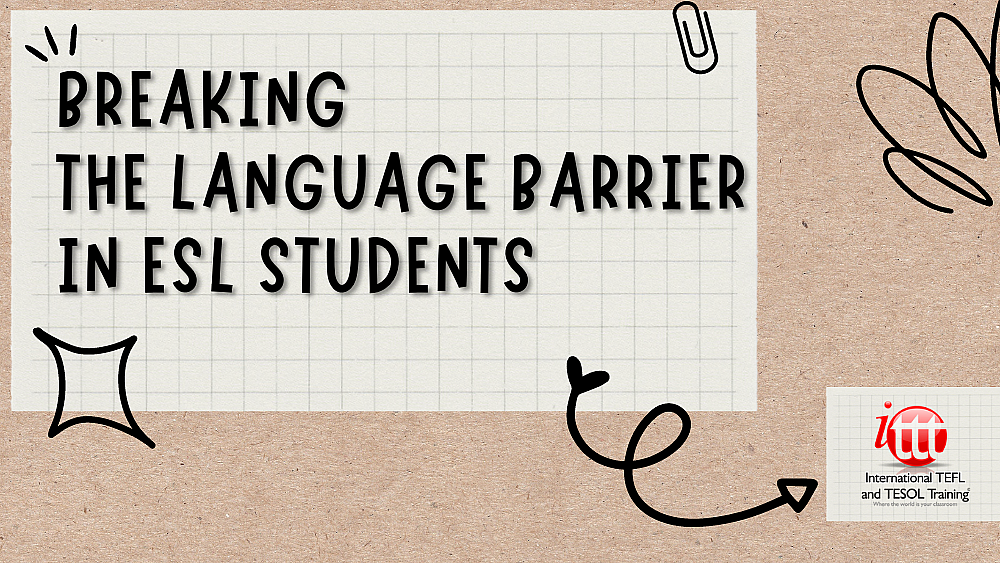Breaking The Language Barrier in ESL Students

Learning a new language differs whether it occurs during early childhood or later in life. Nevertheless, in both scenarios, breaking a language barrier is essential for the student's progress and success. So, how do we break it so students can efficiently communicate in English?
Table of Contents
Are you ready to teach English abroad or online?
Native vs Second Language
When we learn our native language, we are fully immersed in that language. It surrounds us from the minute we are born, and our brains begin making associations immediately. We don't put much thought into it. It just happens. The same occurs with children who acquire two or more languages simultaneously, in parents who speak different languages. When you are thrown into a situation of total immersion, much of the same process occurs. The language surrounds you, and the need to put the language into practice is more significant. Therefore you will risk more and attempt to speak. Opportunities abound. You become highly aware of the language around you and start putting it into use out of necessity. In a classroom setting, replicating complete immersion authentically may not be feasible. However, the same principle of listening and putting learning into practice can be achieved by creating the most authentic situations possible. Initially, though, it's important to explicitly teach basic English. The first step for effective communication is acquiring vocabulary—a repertoire of words to use. Eliciting and pre-teaching language at the beginning of class provides students with communication tools throughout the lesson. Yet, even after acquiring a certain level of vocabulary, it's common for students to feel uncomfortable and uncertain about speaking. Hence, creating a lighthearted and enjoyable environment is essential. In such an environment, both young and older learners feel at ease and comfortable enough to practice and secure enough to make mistakes. A successful teacher can adapt to the needs of various personalities and learning styles. Working with students on a one-on-one basis, teachers only have one student to think of at a time, but there are many to think of in a classroom. Ensuring that you, as the teacher, meet all students' needs is essential for maintaining motivation for learning.
Roleplay
Utilising roleplay is an invaluable tool in the classroom, as it brings real-life situations into the learning environment. Initially, the teacher assigns roles and vocal parts, but as students grow in confidence and vocabulary, they can start creating their own roleplays. It's crucial for the teacher to transition from a traditional, teacher-centered approach to a facilitator role, offering ample opportunities for active student participation. Within a single lesson, the teacher may shift between roles, serving as a lecturer, facilitator, observer, and tutor, depending on the level of student engagement.
Games in ESL
Games are a great choice to help break the linguistic barrier. They provide a great range of possibilities to practice English in a fun and non-threatening way. Adaptable to different content, games can be used as warm-ups or as practice or even students created to apply and show what they have learned. The internet is also always a source of fun. There are online games and a world of English activities to choose from, where students can practice individually or alongside other language learners. Music too is fun, especially for a younger and teenage student. Actual life documents, faxes, company reports, newspaper clippings, and other material can be sourced from the internet. These are authentic resources that make learning real.
Social Networks
Social media serves as a valuable tool in breaking the language barrier, offering English learners a platform for practice and engagement. While older and business English learners can easily incorporate social media into their language learning routine, younger learners may face age restrictions and safety concerns. Nevertheless, the latest technological advancements have provided teachers and students with innovative opportunities for interaction. Teachers often utilise messaging systems to send quick, engaging assignments, allowing busy business English learners to participate conveniently. However, it's crucial to maintain appropriateness in interactions, considering factors such as timing and content, while respecting the teacher-student relationship. Establishing clear guidelines for social media interactions can help prevent misunderstandings and ensure productive engagement.It is possible to build confidence in students by creating a positive and immersive environment. Students are given ample and varied opportunities for speaking and risk-taking: the secure knowledge that making mistakes is acceptable and an inherent part of learning. The focus should be primarily on the learner, making education simultaneously functional and fun.
Are you ready to teach English abroad or online?
APPLY NOW & GET CERTIFIED TO TEACH ENGLISH ABROAD!Email [email protected] or use the 'contact us' page to discuss our courses and teaching English internationally!



